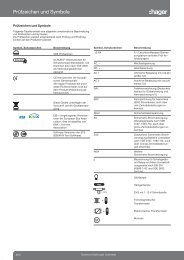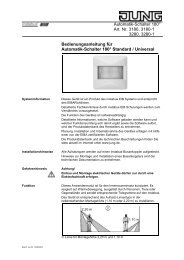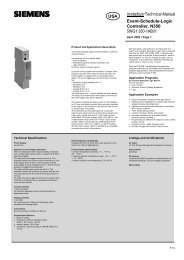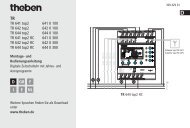Create successful ePaper yourself
Turn your PDF publications into a flip-book with our unique Google optimized e-Paper software.
- "Alarm" status:<br />
If a detector within an armed area responds, the signalling system switches to the "Alarm"<br />
status and activates the internal siren and, with additional external arming, also the visual<br />
alarm.<br />
If an additional detector triggers after a prior alarm, then a subsequent alarm is activated. In<br />
so doing, the internal configured siren is again triggered and, if necessary, switched on<br />
again.<br />
An alarm can only be deactivated by unarming using the switching devices or deactivated<br />
directly on the panel using the appropriate button.<br />
If an alarm delay time was configured in the ETS plug-in, a "Prealarm" can be activated<br />
first. A prealarm can be signalled by the piezo buzzer of the panel and/or by a separate<br />
communication object. The system can be unarmed during a prealarm, without triggering<br />
an alarm. The transition to "Alarm" status then takes place without unarming only when the<br />
appropriate alarm delay time has elapsed, which can be configured separately for internal<br />
and external arming. A subsequent alarm is always activated without delay.<br />
- Status "Unarmed after alarm"<br />
After an alarm was reset through unarming (internal siren deactivated, visual alarm still activated),<br />
the system switches to the status "Unarmed after alarm". After an alarm, the cause<br />
of the alarm must always be determined. In this status, the triggered detectors of the security<br />
area affected by the alarm are displayed in the event memory of the panel (see chapter<br />
4.2.4.12.6. Event memory). In so doing, all the events are logged between system arming<br />
and unarming. In the "Unarmed after alarm" status, there must first be an acknowledgement<br />
using the button of the same name on the panel in order to return to the "Unarmed"<br />
status. The system can only be rearmed when all the previously tripped detectors of the affected<br />
security areas were reset.<br />
- "Fault" status:<br />
The system switches to the "Fault" status when the sabotage detector has tripped or if, during<br />
detector monitoring, at least one missing detector was detected. A fault restricts the<br />
function of the signalling system to such an extent that proper operation can no longer be<br />
guaranteed.<br />
If a fault results from the "Unarmed" status, then the system cannot be rearmed (status display<br />
on the panel "Not ready"). In this case, the fault must be detected using the detector<br />
list and eliminated through acknowledgement (see chapter 4.2.4.12.5. Fault).<br />
In the armed status, sabotage or a missing detector will immediately trigger an alarm. In<br />
this case, the system will only switch to the "Fault" status, after the alarm was acknowledged.<br />
A fault message can be signalled to the bus using the "Fault" object.<br />
Order-No. 7574 00 1X<br />
Software "...590101"<br />
Functional description<br />
Page 114 of 222

















